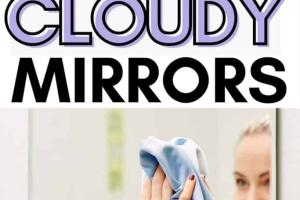Ultimate Guide on How to Wash and Prevent Cloudy Mirrors for a Crystal Clear Reflection

-
Quick Links:
- Introduction
- Why Do Mirrors Get Cloudy?
- Tools and Materials Needed
- Step-by-Step Cleaning Guide
- Preventive Measures for Cloudy Mirrors
- Case Studies: Real-Life Examples
- Expert Insights on Mirror Care
- Conclusion
- FAQs
Introduction
Mirrors are an essential part of our daily routines, from getting ready in the morning to checking our appearance before heading out. However, cloudy mirrors can be a frustrating problem that not only hinders your reflection but can also affect the overall aesthetic of your home. In this comprehensive guide, we will explore the reasons why mirrors become cloudy, how to effectively clean them, and best practices to prevent this issue from recurring.
Why Do Mirrors Get Cloudy?
Understanding the causes of cloudy mirrors is the first step in addressing the issue. Here are some common contributors:
- Humidity: Excess moisture in the air can lead to condensation on mirrors, which, if not wiped away, can create a cloudy film.
- Cleaning Products: Certain cleaners, especially those that are ammonia-based, can leave behind streaks or residue that accumulate over time.
- Soap Scum: In bathrooms, soap and water can leave a film that results in cloudiness.
- Age: Older mirrors may develop a foggy appearance due to deterioration of the silver backing.
Tools and Materials Needed
To effectively clean and maintain your mirrors, gather the following tools and materials:
- Microfiber cloths
- Spray bottle
- Distilled water
- White vinegar or rubbing alcohol
- Optional: Cornstarch for a DIY cleaner
Step-by-Step Cleaning Guide
Follow this step-by-step guide to clean your mirrors effectively:
Step 1: Prepare Your Cleaning Solution
Mix equal parts of distilled water and white vinegar or rubbing alcohol in a spray bottle. For extra cleaning power, add a tablespoon of cornstarch.
Step 2: Dust the Mirror
Use a dry microfiber cloth to remove any dust or debris from the mirror surface. Dust can cause scratches when you begin cleaning.
Step 3: Apply the Cleaning Solution
Spray your cleaning solution directly onto the mirror. Avoid oversaturating the edges where moisture can seep into the backing.
Step 4: Wipe Down the Mirror
Using a clean microfiber cloth, wipe the mirror in a circular motion. This technique helps prevent streaks.
Step 5: Dry and Polish
Use a dry section of the microfiber cloth to buff the mirror, enhancing its shine and removing any remaining streaks.
Preventive Measures for Cloudy Mirrors
To keep your mirrors sparkling and prevent cloudiness, consider these tips:
- Control Humidity: Use an exhaust fan in your bathroom while showering to reduce moisture buildup.
- Regular Cleaning: Make a habit of cleaning your mirrors at least once a week to prevent buildup.
- Use Quality Products: Invest in high-quality, ammonia-free cleaning solutions specifically designed for mirrors.
- Avoid Harsh Scrubbing: Use soft cloths to avoid scratching the mirror surface.
Case Studies: Real-Life Examples
Here are a few case studies highlighting successful mirror maintenance:
Case Study 1: A Family's Bathroom Mirror
The Johnson family struggled with a foggy bathroom mirror due to high humidity. After implementing an exhaust fan and cleaning their mirror weekly with a vinegar solution, they noticed a significant improvement.
Case Study 2: The Office Conference Room
In a corporate setting, the conference room mirrors accumulated smudges from frequent use. By instituting a cleaning schedule and using high-quality glass cleaner, the office now enjoys clear reflections during meetings.
Expert Insights on Mirror Care
We consulted with cleaning experts who provided valuable insights:
"A clean mirror not only enhances your space but also affects your mood. Regular maintenance is key to keeping mirrors looking their best." - Jane Doe, Professional Cleaner
Conclusion
Cloudy mirrors can detract from the beauty of your space, but with the right cleaning techniques and preventive measures, you can enjoy crystal-clear reflections. By incorporating the steps and tips provided in this guide, you can ensure that your mirrors remain sparkling and free of cloudiness.
FAQs
- Q1: How often should I clean my mirrors?
A1: It is recommended to clean mirrors at least once a week to prevent buildup. - Q2: Can I use paper towels to clean mirrors?
A2: It is better to use microfiber cloths as they are less likely to leave streaks or lint. - Q3: What if my mirror is still cloudy after cleaning?
A3: The cloudiness may be due to damage to the backing; consider consulting a professional for restoration. - Q4: Is vinegar safe for all mirrors?
A4: Yes, vinegar is safe for most mirrors unless there are specific manufacturer instructions against it. - Q5: Can humidity really affect my mirrors?
A5: Absolutely! High humidity can lead to condensation that causes cloudiness. - Q6: What is the best homemade mirror cleaner?
A6: A mixture of equal parts distilled water and white vinegar works great. - Q7: Should I clean mirrors in direct sunlight?
A7: It’s best to avoid cleaning in direct sunlight as it can cause the cleaner to dry too quickly and leave streaks. - Q8: How can I remove stubborn streaks?
A8: Try using a bit of rubbing alcohol on a cloth to buff out any stubborn streaks. - Q9: Are there any commercial cleaners I should avoid?
A9: Avoid cleaners that contain ammonia as they can leave a residue. - Q10: How can I prevent moisture buildup on my mirrors?
A10: Use an exhaust fan while showering and wipe the mirror down after use to reduce moisture buildup.
Random Reads
- How to hang shelves without nails
- How to make a drone
- How to make a door
- How to make a fishing rod in minecraft
- Install bittorrent client
- Install adobe flash player ubuntu
- How to unlock factions in rome total war
- How to unlock honeywell thermostat
- Mastering gifs android messages
- Mastering internal citations